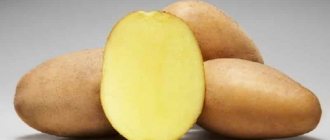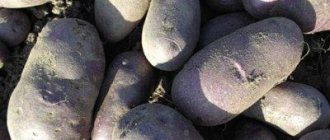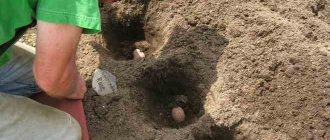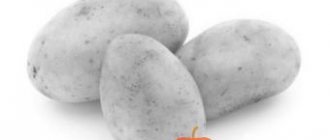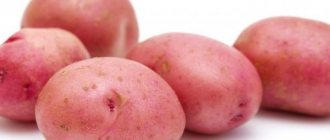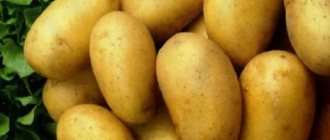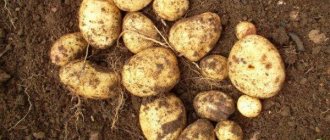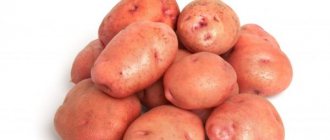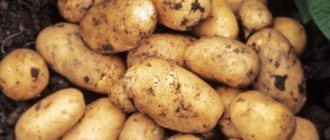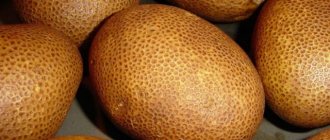Description of the variety
Refers to early ripening varieties with a growing season of 55-60 days. The yield on suitable soil reaches 400 centners per hectare.
The table below presents data on the yield of other potato varieties:
| Name | Variety | Productivity |
| Nikulinsky | Late ripening | From 170 to 300 centners per hectare. |
| Cardinal | Late ripening | From 200 to 350 centners of potatoes are harvested from 1 hectare. |
| Rocco | Late ripening | From 350 to 400 centners per hectare. |
| Kiwi | Late ripening | From 1 kg of planting tubers it reaches 20 kg. |
| Picasso | Late ripening | From 1 hectare about 20 tons. |
| Borovichok | Early ripening | 200-250 centners per 1 hectare of land. |
| Elmundo | Early ripening | 250-350 centners per hectare. |
| Felox | Early ripening | 250 centners per hectare. |
| Bellarosa | Early ripening | The harvest from one bush is 8-10 tubers. |
| Natasha | Early ripening | From 130 to 190 centners per hectare. |
| Forty days | Extra early | Up to 300 centners of potatoes are harvested from one hectare of soil. |
| Karatop | Extra early | From 18.5 to 27 tons per hectare (Middle Volga region), from 20 to 43.5 tons per hectare (Northwestern region). The maximum yield is 50 tons per hectare. |
| Riviera | Extra early | After the first digging on the 45th day after the emergence of potato shoots, it ranges from 134 to 225 centners per hectare. The maximum yield by the end of the growing season reaches 450 centners per hectare. |
| Zhukovsky early | Extra early | The harvest from one bush is up to 15 tubers. |
| Minerva | Extra early | Fertile soils allow you to harvest the first harvest of up to 230 centners per hectare. By the end of the growing season (45-50 days), the maximum yield is achieved - up to 430 centners per hectare. |
| Crane | Mid-late | 640 centners per hectare. |
| Sorcerer | Mid-late | Productivity varies from 27 to 35 tons per hectare. |
| Mozart | Mid-late | The average yield is approximately 430 c/ha. |
| Grenada | Mid-late | From one hectare you can harvest up to 60 tons of potatoes. |
| Ramona | Mid-late | The yield is consistently average from 10 to 15 tons per hectare. |
| Yanka | Mid-early | The average yield ranges from 195 to 315 centners per hectare. |
| Giant | Mid-early | The average harvest ranges from 290 to 424 centners per hectare. |
| Tuscany | Mid-early | Productivity varies from 210 to 400 centners per hectare. |
| Purple Haze | Mid-early | Productivity varies from 182 to 309 centners per hectare. |
| Santana | Mid-early | The average yield varies from 164 to 384 centners per hectare. |
Bushes
The plant forms a low compact bush. The leaves are slightly wavy and dark green in color. The root system is well developed - an average bush produces about 20 tubers, a productive one can produce up to 50 root crops.
Tubers
The weight of one potato ranges from 90-200 grams. The commercial quality indicator is more than 90%. The pulp is cream-colored and does not darken when cut. The peel is thin and yellow.
Root vegetables have the following taste characteristics:
- Rich delicate taste;
- Minimum water content.
Varieties
Attention! Sale of SEED potatoes at competitive prices! THOSE INTERESTED – SEE OUR ADDRESS AND DIRECTIONS HERE!!!
Warehouse address in Voronezh: VAI district (Left Bank) st. Irkutskaya, 1-B, warehouse No. 6 (territory of the former vegetable warehouse) - entrance opposite the FSIN Institute
From 9-00 to 17-00, without breaks and weekends. Seed potato varieties presented for sale in 2015 are marked with a red plus.
Description of potato varieties, characteristics, photos. An early variety of German selection with yellow pulp and round tubers. Ideal for washing, packaging and mechanical peeling.
+ Variety IMPALA (Impala Potato) A very early variety of table potatoes, the most popular today. Seed potatoes of the Impala variety are always sold out first.
It gains weight very quickly and produces a stable harvest in any summer. Impala potatoes are ideal for southern regions, giving the opportunity to receive two harvests per season.
More details + Variety ZHUKOVSKYRANNIY (Zhukovsky early potato) A very early potato variety with high marketability of tubers. Patent holder: GNU VNII POTATO FARMING NAMED AFTER A. G. LORHA.
The variety produces high, stable yields in various soil and climatic conditions. When planted in the soil, the tubers actively germinate, even at low temperatures.
More details >>>+Potato variety BELLAROSA (Potato Bellarosa) Potato Bellarosa is a very early and high-yielding variety. Even earlier than the Impala. Selection - German, patent holder - EUROPLANT PFLANZENZUCHT GMBH.
Among other early varieties, it has a very high keeping quality. Has a good presentation. When grown for food purposes, you can get large, beautiful tubers.
Read more about Bellarosa potatoes.+Vineta variety (Vineta potato variety)Vineta is an early-ripening, high-yielding potato variety of German selection. Widely distributed in Europe, especially popular in Germany.
Has excellent taste. It has all the advantages of German varieties - it is universal in use, flexible in relation to soil and climatic conditions, and does not degenerate for a long time when grown in one place.
More details >>>+Variety UDACHA (Potato Udacha) Refers to early ripening varieties, adapted to various types of soil and climatic zones. Originator: VNIIKH im. A. G. LORHA, GNU.
Resistant to all types of tuber diseases. More details >>>The Belarusian potato variety Skarb is the most popular in its homeland. According to the ripening period - mid-season, for table use, with yellow flesh.
Potato variety ARTEMIS (Potato Artemis) An early ripening variety of table potatoes. Dutch selection, originator - AGRICO BA Allows you to get an early harvest in the middle zone.
A very promising potato variety, almost an analogue of the Impala variety. More details >>>+Variety ROMANO (Potatoes of the Romano variety)Mid-early potato variety. The originator is AGRICO BA (Netherlands).
One of the best varieties, valued for its high yield and beautiful appearance of tubers. A variety for universal culinary purposes. More >>>+NEVSKY variety (Nevsky potato variety)According to many years of testing, the mid-early Nevsky potato variety proved to be the most productive of domestic varieties.
In terms of productivity, it is close to the best Dutch varieties. More details >>>Potato variety ELIZAVETA (Potato Elizaveta) High-yielding table potato variety of Russian selection. Belongs to the mid-early group.
Cultivation care
We recommend reading our other articles
- Grape variety Izyuminka
- Lada pear variety
- Grape variety Zabava
- Description of the Ethiopian melon variety
Hilling potatoes photo
The same amount of time is spent caring for Rodrigo potatoes as any other variety. With proper attention, the harvest should last throughout the winter, and for sale!
- Watering is carried out rarely, abundantly. During the season, you can simply water the potatoes well three times, this will be enough even in a dry summer.
- Weeds are removed as they appear; this procedure can be combined with loosening the rows, hilling or watering.
- If a gardener wants to use herbicides to get rid of weeds on potato plantings, then it is better to do this before sprouts appear, since Rodrigo potatoes do not like such chemicals and can slow down growth.
- In order for the tubers to grow strong, it is worth watering the bushes at the root with calcium nitrate. You need about 2 waterings per season, but you can get by with just one.
- Rodrigo potatoes are resistant to cancer, nematode, scab, and late blight, but sometimes they can still get sick, so preventive treatments will not hurt.
- Preventative treatment is carried out against pests if there are none. The Colorado potato beetle is collected manually or the plantings are sprayed with a suitable insecticide “Aktara”, “Tabu”, “Molniya”, “Commander”.
Harvesting is usually done in 2 stages. Some potatoes are harvested young, and the rest of the crop is harvested when it reaches final ripeness. Before harvesting, the bushes are cut off - only the stumps are left. The potatoes are dug up and laid out to dry. Store dried potatoes after digging in a dry, dark room with a temperature of about +3 degrees Celsius. To ensure high safety, it is better to sort the tubers before storing them for the winter.
Harvesting
When the stems of the bush begin to fall and wither, the harvest is ready. Two weeks before harvesting root crops, all tops should be removed from the area. Tubers are usually harvested in late August - early September.
After harvesting, the tubers are laid out and dried on the edge or under a canopy. Then the potatoes should be sorted, removing rotten ones or those with signs of disease, so as not to infect healthy tubers with rot. Potatoes are stored in the cellar, and in winter they must be sorted out 2-3 times to remove spoiled root crops.
Tubers are harvested by the end of August - beginning of September
Growing potatoes in stationary beds - varieties Timo and Rosara, Latona and Rassvet
When in 2011 I received a “killer” potato harvest at my summer cottage, I decided to completely reconsider the agricultural technology of growing this crop. I started with seeds. I purchased extra-early potato varieties Timo, Rosara (they have a growing season of 60-70 days) and mid-early varieties - Latona, Rassvet (ripening period 70-85 days). Since our summer is short, I built four stationary beds to quickly warm up the soil: these boxes made of boards measuring 10x1.2 m and a height of 25-30 cm, oriented from south to north; the distance between the boxes is 0.7-0.8 m. At the bottom of each box I laid wood leaves, old sawdust, unripe compost, and covered it with a layer of humus on top.
After which I watered all the beds with an infusion of organic matter. In late autumn, I cut two ridges in the rows at a distance of 60 cm from each other. In the spring, as soon as the snow began to melt (for us this is the end of the second ten days of April), I covered the beds with plastic wrap to warm them up. To get an early harvest, I decided to use the seedling method using the Timo variety, which, after vernalization, was planted in sawdust for germination on April 18. These sawdust were periodically moistened with a solution of mineral fertilizers - 10 liters of water:
potassium chloride -1 tbsp. l*superphosphate – 2 tbsp. l., urea - 1 tbsp. l.
After 20 days, the height of the seedlings was 10-15 cm. Potatoes of all 4 varieties were planted on May 8-9 on ridges in a checkerboard pattern, the distance between tubers was 25-30 cm. From night frosts, the beds were covered with lutrasil. At the end of May, the height of the tops of the Timo variety was already reached 25 cm, and three other varieties planted in the usual way began to germinate on May 20-22.
Three weeks after planting, I weeded Timo’s potatoes, filling the middle of the bush with soil to increase tuberization, and covered the entire bed with a 20 cm layer of straw. On June 14, Timo bloomed, and on June 25 I started digging it up, and finally removed it until July 12. The harvest amounted to about five buckets, there were no small change. It took 78 tubers for planting, some of them cut. All the work on growing potatoes in a box, after a single weeding, came down to two waterings, since the summer turned out to be dry, mowing the tops and harvesting hay from the bed before digging the potatoes and spraying in three weeks before cleaning with a solution of mineral fertilizers - per 10 liters of water:
double superphosphate -2 tbsp. l., potassium sulfate - 1 tbsp. l., boric acid - 1 tsp., copper sulfate - 1 tsp.
I used this method on the rest of the beds. After receiving the first harvest of Timo potatoes, I mulched the bed with a layer of compost, watered it with an infusion of organic matter and let it sit for three days. On July 16, I loosened the bed with a flat cutter and planted the second batch of Timo seedlings. On September 29, I collected my second harvest. I dug four buckets. In total, Timo collected nine buckets of potatoes from one bed during the season. I dug up so much in 2011 from one hundred square meters...
Rosara was pleased: he dug up six buckets. The tubers are large, bright red in color, yellow flesh, excellent taste, up to 15 pieces per bush. Stores well. Latona – yellow tubers, medium size, good taste. It tolerates drought well, the variety is resistant to late blight. I dug up five buckets. Dawn - white tubers, crumbly when cooked, up to 20 on a bush. The variety requires good care. I dug up four buckets.
The creation of stationary beds is justified in small summer cottages, on heavy soils, as well as in the northern regions. Despite the seemingly costly nature of setting up permanent beds, over time their advantages clearly manifest themselves: a stable harvest and low labor costs, and most importantly, there is no need to dig anymore! This is an early variety.
The bush is low, well leafy, the stems are slightly pigmented, the leaves are large, the flowering is weak, the flowers are blue-violet. Accumulates harvest until late blight appears. The growing season is 60-70 days.
Tuber: the color of the peel is light yellow, the color of the pulp is light yellow, the shape is round, the depth of the eyes is average, the sprouts are blue-violet. The average tuber weight is 70-120 g, the number of tubers per bush is 5-9, the average yield with early harvesting is 180-240 c/ha, with late harvesting 290-320 c/ha.
Shelf life is satisfactory. The taste is good. It does not fall apart during heat treatment. The pulp does not darken when cut.
Starch content 12-14%. Moderately resistant to viral diseases and common scab. Resistant to potato blight.
Leave feedback
Characteristics and properties
The Lapot potato variety is positioned as a mid-early table variety. Compared to other varieties, Siberian potatoes stand out, first of all, in the size of the tubers and, of course, in their productivity.
The Lapot potato variety has the following description:
- the growing season ranges from 65 to 80 days;
- Full ripening of potatoes occurs from the second half of August to the twentieth of September (depending on weather and climatic conditions);
- the height of Laptya bushes is average - about 50-60 cm;
- bushes are dense, well-leafed, spreading;
- medium-sized leaves, light green in color;
- the flowers are large, snow-white, the potatoes bloom abundantly;
- the shape of the tubers is oblong, flattened - outwardly the potatoes resemble rustic bast shoes;
- the peel is colored dark pink;
- the pulp of the tubers is creamy, with an average starch content (12-14%);
- Potato eyes are small and located superficially;
- under each bush there are 6-8 potatoes;
- the weight of marketable tubers is 100-160 grams;
- necessarily one tuber from the bush stands out in size - the mass of such “bast shoes” can be 500-600 grams;
- the productivity of the Lapot variety is high - about 450-500 centners per hectare;
- the taste is decent - the root vegetable is perfect for frying, baking, stewing, preparing first courses and salads;
- the keeping quality of the crop is 94%, which is considered a good indicator for an early variety;
- Lapot potatoes are very resistant to weather conditions, such as drought, prolonged rains, and recurrent frosts;
- the soil, like the climate, is suitable for growing the variety;
- Lapota is not immune to Alternaria and late blight and can be affected by other fungal infections;
- Potatoes are rarely infected with other diseases.
By the way, most agronomists do not recognize the existence of such a variety. They believe that Lapot is one of the wild varieties of potatoes bred during Soviet times. It is believed that the predecessor of the Siberian folk potato was a variety such as American or Northern Rose.
What determines the love of farmers
Lapot potatoes have many advantages. Indeed, everything about this potato is impressive – not just its external qualities. The strengths of the variety are:
- size and presentation of tubers;
- excellent taste;
- suitability for transportation;
- low damage to tubers;
- suitability for long-term storage;
- universal purpose - table variety belongs to category AB;
- resistance to cold (even during spring frosts, potato seedlings do not need to be covered);
- independence of yield from the weather in the summer season (even in a cold summer, Lapot will give a decent harvest, only the timing of its harvest will be delayed);
- incredible “flexibility” of potatoes, allowing the variety to acclimatize in any climate and on any soil;
- a small percentage of tubers spoiled during storage (about 5-6%).
Of course, a description of the Siberian variety will be incomplete without mentioning the shortcomings of this potato. Unfortunately, the variety also has disadvantages:
- very weak resistance of bushes to late blight of tops and Alternaria;
- frequent damage to tubers by wireworms (larva of the click beetle);
- lack of quality planting material.
Potatoes of the Lapot variety are not included in the State Register; they do not have an originating company, so it is impossible to find planting material in specialized nurseries. The only way to get tubers for planting is to buy them from private gardeners. And this does not guarantee that the potatoes comply with varietal qualities.
Description of the potato variety Lapot and photos of tubers
There is little information about how this variety appeared. Well-known breeders did not deal with it. Many believe that the Lapot potato was bred using the method of so-called folk selection in the mid-twentieth century in Russia. The resulting variety was named Laptem for the size and shape of the tubers.
The Lapot variety always pleasantly surprises with its large tubers and stable yields
Since then, it has long remained one of the most sought-after varieties. True, recently it has been supplanted by new representatives of the potato tribe, mainly of foreign selection.
Laptya's bushes are medium or tall, the inflorescences are white and lush - real bouquets. But what interests us most is, of course, the tubers, right? They have a flattened, elongated shape, covered with a light pink peel that is slightly rough to the touch. With an average level of starch content in tubers, Laptya has excellent taste.
This potato has high yield. From 1 hundred square meters they usually get 400–500 kg of products. You can start harvesting from mid-August, or you can postpone it until September. He is quite democratic in terms of cleaning.
Table: advantages and disadvantages of the variety
| Advantages | Flaws |
| Very large tubers with good taste. | The variety is considered old; many gardeners replace it with more modern varieties, so it is difficult to obtain planting material. |
| The variety is frost-resistant, tolerates frost well when seedlings emerge and cold snaps during growth. | Susceptible to diseases such as late blight and alternaria. The wireworm loves the tubers of this variety. |
| Undemanding to the type and composition of soil. | |
| Thanks to good immunity, it is not susceptible to many major diseases and pest attacks. |
Laptya has many more advantages than disadvantages
How to properly care for the variety
The unpretentiousness of the variety makes care accessible even to novice gardeners. Regular implementation of the procedures will allow you to get a rich harvest.
Features of watering
Lapot potatoes are resistant to drought, but with regular watering, the possibility of obtaining a higher yield increases. Irrigation is carried out several times per season:
- a couple of weeks before emergence;
- during the formation of buds;
- during the period of tuber mass gain.
Note! In very dry summers, the amount of watering can be increased, but moisture stagnation should not be allowed to avoid rotting of the tubers. Irrigation is best done between rows; watering bushes provokes the development of fungal diseases.
Feeding and fertilizing
For the Lapot potato variety, fertilizers are not too important. It is allowed to apply organic fertilizers several times. It is necessary to fertilize during the period of sprouting, when the first flowers form and during full flowering.
Advantages and disadvantages
The Belarusian potato variety Skarb is grown in its homeland, Ukraine and Russia because of its undeniable advantages, which make this potato a permanent resident of fields and vegetable gardens. In addition to excellent yield, the advantages of the variety include resistance to pests and diseases, excellent preservation of tubers and a long shelf life.
Scarb also has disadvantages:
- its tops and then tubers are susceptible to late blight;
- plants are sensitive to waterlogging at the beginning of the growing season;
- in areas where crop rotation is not observed, plants can be affected by ring rot, which is why some of the crop is lost during storage.
A peculiarity inherent in the variety is that potatoes intended for planting in the ground do not germinate well, so the seed material needs to be warmed up. It should also be noted that in the spring, seedlings appear in the beds slowly and unevenly, but then level out.
Disadvantages of the variety
Do bast potatoes have any disadvantages? Reviews from experienced gardeners reveal the following disadvantages of the variety:
- Low resistance to Alternaria and late blight. Lapot also does not tolerate pests such as wireworms.
- Lack of quality planting material. “Lapot” is not included in the State Register and does not have an official originator. In this regard, this variety is almost impossible to find in nurseries and catalogs. In garden plots it is gradually being replaced by new official varieties. So it will be quite difficult to get tubers for planting.
Planting and growing potatoes
Romano potatoes are not picky about growing conditions, but some minimum recommendations for choosing a location for plants must be followed.
Did you know? Potatoes were introduced into Europe around 1580, but were long considered unsuitable for food.
This will help get the maximum yield from the bushes and prevent problems from occurring.
- be well lit - in the shade the plants will grow much worse and the tubers in the nest will be small;
- have loose and nutritious soil - in heavy soil, planting material germinates worse, and a lack of fertilizer affects the quality and volume of the harvest;
- do not contain groundwater lying close to the surface of the earth - bushes react poorly to waterlogged soil. If potatoes are planted in an area with high groundwater levels, then planting should be done on ridges;
- to reduce the risk of diseases, it is not recommended to plant Romano potatoes in areas where tomatoes, peppers or eggplants were previously grown;
- A good harvest of tubers can be obtained if you plant the Romano variety in an area where grains or legumes, cabbage, greens, beets or carrots previously grew.
Mid-early potato varieties also include such as “Nevsky”, “Sante”, “Manifesto”, “Tuleevsky”, “Breeze”, “Zekura”.
Selection of planting material
In order for Romano potatoes to produce a good harvest, you need to start growing them with proper planting of the fruits. Proper preparation of seed tubers helps to obtain the first green shoots within 8–12 days after planting.
Let's consider the basic rules for selecting and preparing potatoes for planting:
- tubers must be free from deformation, damage and rot;
- the weight of one fruit should be about 80 g;
- 20 days before the planned planting, seed tubers are laid out in a warm (+14...+16°C) and well-lit place for germination;
- To prevent seed potatoes from drying out in a warm room, they are periodically sprayed with warm water;
- for better germination, seed tubers are treated with a solution of mineral fertilizers or a growth stimulator;
- to increase the plant’s immunity to diseases and pests, tubers are treated with fungicides before planting;
- if the potatoes are too large, then before planting the fruits are cut into pieces so that each of them has 2-3 eyes.
Important! Tubers are planted after sprouts up to 5 cm long appear on them.
Soil preparation
The highest yields are achieved when this variety is grown in fertile and loose soil.
Other types of soil require little preparation before planting potatoes:
- add lime or ash to acidic soil;
- dense clay soil is diluted with humus or peat (1 bucket is enough for 1 m²);
- sandy soil is fertilized with humus and diluted with clay soil;
- compost or manure, clay and coarse sand are added to peat soil.
In the fall, it is recommended to carry out deep digging of the site. This will help prevent the occurrence of diseases and improve the breathability of the soil. Before planting in the spring, the soil is dug up again to a depth of 20 cm and loosened with a harrow.
Planting potatoes
The timing of planting Romano potatoes in open ground largely depends on the climatic conditions of a particular region. For the southern regions, planting is possible as early as mid-April, provided that night frosts are not expected. In other regions, potatoes are planted in late May or early June.
Did you know? When exposed to direct sunlight, solanine, a substance poisonous to the human body, accumulates in potato tubers.
The process of planting Romano potatoes is described below:
- Dig holes in the soil 10–20 cm deep, placing them in rows at a distance of 60–80 cm from each other. The lighter the soil on the site, the greater the depth of the hole. Between the rows you need to leave a distance of about 50 cm.
- If the soil on the site is too dry, then the holes can be watered a little.
- Add humus, a handful of ash or mineral fertilizers to each hole.
- Place seed potatoes in the hole, sprouts facing up. If small fruits weighing about 20 g are used for planting, then 2-3 tubers should be placed in one hole.
- Sprinkle the hole with soil and slightly level the surface.
If Romano potatoes are planted in sandy soil, and the growing region is characterized by a hot, dry climate, then it is recommended to place the tubers in trenches up to 10 cm deep.
The best potato varieties
Not all people can imagine that potatoes can be quite an expensive and exclusive food. Today, potatoes mainly serve as the basis of the diet of the average person. And most people find it difficult to even imagine that someone is willing to pay hundreds of thousands of dollars for this seemingly ordinary vegetable. Meanwhile, this is really true. The root crop of the La Bonnotte variety is considered one of the most expensive products in the world. It can only be tasted in the most elite and luxurious restaurants. Not everyone can afford a dish prepared with such delicious potatoes.
One kilogram of potatoes of this variety costs 500 euros. Agree, it’s not very cheap. According to culinary experts, dishes based on these potatoes have a soft, delicate and slightly salty taste. This high cost is also due to the fact that only 100 tons of vegetables can be harvested in a year, because they grow in only one place. The technology of its cultivation is kept secret and passed on from generation to generation.
Potatoes of the La Bonnotte variety are grown on the French island of Nurmoitiers, in the Atlantic Ocean. The land on which miracle potatoes are grown is fertilized only with algae, nothing else. The crop is harvested exclusively by hand, as the potato tubers are unusually tender. If you collect them with mechanized equipment, you can quite easily crush the valuable product.
For ordinary agricultural companies, the process of growing this type of potato is very unprofitable. You need to invest a lot of material and physical costs. And this is not always a justified risk.
Such fragile potatoes are planted in February. This is done in order to harvest the crop in the first weeks of May. The bushes grow in a specially prepared bed, no more than 70 centimeters wide. The beds are made by soil pressing. This technology creates the most favorable conditions for plant growth and tuberization. The soil is ventilated and warmed up as much as possible. The collected root vegetables are sent for sale to elite restaurants on the same day that the harvest took place. You need to eat the potatoes immediately, otherwise they will lose their flavor.
It is this soft, pleasant taste of French potatoes, as well as completely handmade work, that gives the root vegetable its high cost.
Potatoes Lasunak (Lasunok) variety description: You've probably heard a lot about it - let's organize the information:
- Brought out by the Belarusian Research Institute of Potato Growing. Medium-late, table purpose, growing season, harvest formation 80-100 days (up to 120 depending on the climatic zone and weather conditions).
- Starch 15-22%.
- The tubers are short-oval, white with a mesh skin, the flesh is light cream, the eyes are deep set. The average weight of the tubers is 150-200 g.
- The bush is erect, with a thick stem, medium foliage, leaves with hard pubescence, sufficiently thickened. Thus, potatoes are not affected by the Colorado potato beetle - they simply become inaccessible and practically inedible due to their pubescence.
- The flowers are white, the inflorescence is multi-flowered.
- The maximum yield is up to 620 c/ha (up to 60 t/ha), with moderate agricultural technology - about 40-45 t/ha.
- It stores well - a variety with a short dormant period. To avoid germination and development of putrefactive processes, the recommended storage temperature is +7 C - cold.
- High resistance to late blight, resistant to verticillium wilt and nematode.
- The taste is excellent: crumbly, appetizing pulp - as they say, the potatoes boil well, great for mashed potatoes, soups, salads, fries and chips. Universal purpose, suitable for both starch production and the culinary industry - French fries, chips, etc.
Recommended planting scheme Lasunka 70x35 cm, depth 8-10 cm for sandy loam soils, on loam - 5-7 cm.
It is recommended to speed up the harvest by germination in the light, vernalization, and effective planting by dividing the tuber.
It is worth avoiding excess chlorine-containing potassium fertilizers - it reduces the starch content in tubers, as well as the yield of all potato varieties. In addition, chlorine slows down the growth of tubers in the fall.
- Responsive to timely watering.
- During the growing season, for higher yields, foliar fertilizing with organic fertilizers, potassium + phosphorus is recommended. There is no need to overuse it: there is no need to cover it with humus or run around with a bag of saltpeter.
Pests
Potatoes of the Azart variety suffer from a nematode - a tiny worm up to 1 mm long. Despite its barely noticeable size, the pest is capable of destroying more than half the crop.
Pest eggs overwintering in the ground can withstand severe frosts. He is not afraid of dry and rainy weather. It multiplies very quickly.
The golden and pale nematode, getting into the root of the bush, feeds on the juices, which prevents the flow of nutrition to other parts of the plant. The bush dries out prematurely, the tubers are small or not formed at all.
Stem nematode destroys stems and tubers. The nematode is a dangerous enemy; the fight against it must begin at the first sign of the appearance of the pest.
Nitrate fertilizers are a poison for the nematode; adding urea in the fall is one way to reduce the worm population.
Earthworms are natural enemies of nematodes; when fertilizers are added to the soil, favorable conditions are created for the reproduction of earthworms.
The nematode is afraid of secretions from the roots of legumes, rye, marigolds, and calendula.
For your information. When the pest concentration is high, strong chemicals are used.
Preparatory stage and planting
One of the advantages that the “bast” potato variety has is its unpretentiousness. However, if you want to get a stable harvest, you will still have to allocate some time for planting and care. It is also worth remembering the need to prevent diseases that pose a particular danger to this crop.
The article contains photos of bast potatoes. The description of the variety and reviews from gardeners confirm that this is a large and beautiful root crop. What should you do first if you decide to plant it in your summer cottage? The most important step is choosing a location for the garden bed. This species loves sunlight and warmth, so it is better to give it an open place. As mentioned earlier, “bast shoes” are unpretentious to the type of soil. But it won’t grow in a swamp either. Groundwater should not come closer to the soil than 65-70 cm. Like any other potato, “bast potato” does not tolerate acidic soil. Determine the acidity level in advance and, if necessary, add a “deoxidizer” to the soil. You can prepare this composition yourself using sifted wood ash, dolomite flour and crushed eggshells. You should prepare a bed for planting potatoes in advance, in the fall.
Features of cultivation
Agricultural technology for this variety is standard. The seed material is sprouted tubers; potatoes are grown in open ground; depending on the region, they are added to the soil in April-May.
The sowing pattern is 60*35 cm, the planting depth is shallow, no more than 5 cm, the hole with the tuber can simply be sprinkled with earth for the speedy appearance of powerful and friendly shoots. Such small embedding then requires obligatory hilling of the bushes.
Attention: this variety is recommended to be grown after flax, annual or perennial grasses or winter crops. Potatoes are fed to increase yield and speed up the growing season
For the first time, you can spray only the emerging shoots with a nutrient solution.
Potatoes are fed to increase yield and speed up the growing season. For the first time, you can spray only the emerging shoots with the nutrient solution.
During the development of tops, you can feed the plants with a solution of 0.5 liters of manure in a bucket of water, adding this liquid under each bush.
Gardeners traditionally use nettles that have rotted in water to feed potatoes. 10 kg of finely chopped nettle can be kept in a 100 liter barrel of water for a week, then add a bucket of manure, mix and pour about 1 liter of the resulting fertilizer under each bush.
They feed the second time when the bud develops, taking 1 glass of ash per bucket of water, pour half a liter of the solution on each bush. During flowering, fertilize for the third time, diluting 1 glass of manure per 10 liters of water, and also add half a liter of liquid to each bush.
For more information about what, how and when to fertilize potatoes, and how to do it correctly when planting, read the detailed materials on the site.
After planting, it is not recommended to water the potatoes, since in this case the roots will grow to a sufficient depth.
The need for watering is moderate; you can judge by eye the beginning of withering of the lower leaves of the bush. Watering early in the morning or evening with water from a barrel heated to a temperature of 15-20 degrees. During the flowering period, you need to water more abundantly.
Be sure to periodically loosen the soil to a depth of 2-3 cm to improve root respiration and at the same time weed out small weeds
You need to start loosening a week after planting; during the operation, you need to be careful not to damage the stems and not dig up the nodules ahead of time. Mulching can also be used to control weeds. Hilling is also necessary, as for any potato variety, this is necessary to speed up the growing season, as well as to prevent late blight
Hill up stems 15 cm high for the first time, and 12 days after the first for the second time.
Hilling is also necessary, as for any potato variety, this is necessary to speed up the growing season, as well as to prevent late blight. Hill up stems 15 cm high for the first time, and 12 days after the first for the second time.
Of course, it is necessary to identify and destroy plant pests as they appear.
The fight against the Colorado potato beetle and its larvae very often becomes a real problem for gardeners.
We bring to your attention a series of materials about folk remedies and chemicals that can cope with the problem.
Thus, Timo Hankkiyan is one of the most popular varieties of early ripening potatoes, zoned throughout the country.
Potatoes have a fairly high yield, excellent taste, and can be dug up within 50 days after planting.
We also invite you to get acquainted with other varieties that have very different ripening periods:
| Very early | Early ripening | Mid-early |
| Farmer | Bellarosa | Innovator |
| Minerva | Timo | Handsome |
| Kiranda | Spring | American |
| Karatop | Arosa | Crown |
| Jewel | Impala | Manifesto |
| Meteor | Zorachka | Elizabeth |
| Zhukovsky early | Colette | Vega |
Growing potatoes, both for personal consumption and on a business scale, can be done in a variety of ways. We want to introduce you to Dutch technologies, to growing under straw, from seeds, in barrels or bags, in boxes or boxes without a bottom.
Care
Potatoes have a long pre-emergence period, and when planted in fertilized soil there is a risk of growing a rich crop of weeds. Therefore, no later than 5–6 days after planting, they begin to loosen the soil. The roots of weeds are still tender at this time; they die quickly. It is recommended to carry out the next loosening after a week, this way the remaining weeds are destroyed. After the first potato seedlings appear, they begin to process the row spacing.
If the summer is not very dry, you don’t have to water the potatoes until they bloom. But during the flowering period, the plants are watered abundantly with warm water, avoiding its contact with the leaves. Depending on the condition of the soil and the amount of precipitation, only 2–3 waterings are needed during the entire potato growing season.
During the flowering period, potatoes are watered abundantly.
Fertilizing in the form of an infusion of nettle or other weeds has a good effect on plants. To reduce moisture evaporation and reduce the frequency of watering, mulching potato bushes with grass or cut green manure is used. When overheated, they provide plants with organic matter and moisture.
2–3 weeks before harvesting, they stop watering the potatoes, and 7–10 days before harvesting, cut off the tops of the bushes so that the soil dries out faster and the tubers ripen.
Late blight prevention
- If you have to plant potatoes in the same place for the second or third time, before planting the tubers, the area is spilled with a 3% solution of copper-containing preparations: Bordeaux mixture or copper sulfate. In this case, the tubers are not treated with Fitosporin, since copper preparations suppress its effect, but other means are used - Maxim or Prestige.
- After the tops appear, the bushes are treated either with copper preparations or with a well-proven contact agent - Thanos. It remains on the leaves and stems of potatoes, preventing late blight spores from spreading throughout the plant. Another effective contact drug is Shirlan.
- Sometimes gardeners take the path of stimulating tuber formation in order to get a harvest before late blight has time to develop. For this purpose, the tubers are treated with the drug Immunocytophyte.
- Traditional methods of combating late blight (for example, spraying with lactic acid solutions) are used only as a preventive measure. At the first signs of disease, it is necessary to treat the plantings with fungicides, and it is best to alternate the drugs so that there is no addiction.
Planting care
Do you think your troubles with potatoes end after planting? It is not that simple. Any crop requires care during growth. And even such an unpretentious variety as Lapot is no exception
Pay attention to several rules of care that will ensure a high yield.
Watering
Potatoes need moisture, especially in dry areas. The irrigation scheme is based on several periods:
- 2 weeks after the shoots appear (the shoots at this time rise 5–10 cm above the soil level).
- Buds appeared on the plant. At the same time, tubers form.
- The first half of August - the tubers begin to gain mass.
If the weather is dry and warm, water once every 4 days; at average temperatures and rainfall, it is better to water once every 8–10 days.
The best time for watering is evening. In the morning, the rapidly growing sun can burn the leaves and stems in places where moisture remains, and on a hot day, the water will quickly evaporate before it has time to reach the roots. In August, significant drops in temperature at night are possible, so watering should be planned so that the plants dry out before dark. Otherwise, the potatoes may get late blight.
It is convenient to water potatoes in large plantings using the sprinkling method.
Experienced gardeners have calculated that 3 liters is the optimal volume of water for each bush. Light soils will need more of it than heavy soils. On clay soils, which retain moisture longer but do not allow the roots to breathe, it is better to use the so-called dry watering method: immediately after germination, carefully loosen the soil around the bushes so that the root system does not suffer from a lack of oxygen.
It is very convenient and useful to use mulch on potato beds. In this capacity, you can use any type of organic matter, for example, rotted sawdust or mowed grass. A layer of mulch will retain moisture in the soil after rains and dew, provide coolness during the hot part of the day, and over time it will rot and become a fertilizer itself.
In addition, it is imperative to provide the potatoes with timely fertilizing, which increases the number and size of tubers.
Table: feeding potatoes
| Type of feeding | Time and method of application | Composition and proportions |
| Urea (root feeding) | At the beginning of bush growth, first lightly loosen the soil. | 1 tablespoon per 10 liters of water, each plant requires 0.5 liters. |
| Herbal infusion (root feeding) | In June (the time of active nitrogen consumption by potatoes), it is better to do it in the evening. | Fill the weeds with water and wait for fermentation. The resulting infusion is the color of weak tea leaves. |
| Mineral fertilizers (root feeding) | After light weeding, but before the main hilling. |
|
| Urea (foliar feeding) | The first time is carried out a couple of weeks after germination. Then - every two weeks until the potatoes bloom. | 100 g of urea, 150 g of potassium monophosphate, 5 g of boric acid per 10 liters of water. For the first spraying, the solution is diluted twice, and subsequent times it is used without dilution. You can add 1 g of soluble preparations of zinc, cobalt, copper and manganese per 10 liters of water. |
| Phosphorus (foliar feeding) | At the end of flowering, a month before harvesting. | 100 g of superphosphate per 10 liters of water - the volume is enough for 10 square meters. m. |
| Humates (foliar feeding) | When the fourth leaf appears on the seedlings, then after two weeks. | The drug Gumat+7 (2 g) - per 100 sq. m consumes 3 liters. |
| Nettle infusion (foliar feeding) | During active growing season, with an interval of 10 days between treatments. | Soak the above-ground part of the nettle in water and wait for fermentation. Then dilute the solution with water to the color of weak tea leaves. |
About the features of cultivation
You can significantly increase the yield of Lapot potatoes if you use mineral and organic fertilizers at the same time.
The tubers of this potato form normally without additional watering, but during the formation of buds and an increase in green mass, the Lapot variety will respond positively to additional moisture.
Now it is very difficult to find seed material for potatoes of the Lapot variety; no one is specifically doing this. The vegetative method of propagation remains. When using it, all the qualities of the mother plant are preserved, but you will have to select planting material especially carefully, rejecting tubers even with minor defects.
The vegetative method of propagation preserves the characteristics of the mother plant
Harvest and storage
Harvesting begins when the tops begin to turn yellow and wither - this is a sign of ripeness of the fruit. Dig up potatoes with a pitchfork to avoid damage to the tubers, retreating 30 cm from the bush.
With fertile, loose soil, you can do without digging, but simply rake the soil with your hands, since the tubers of the variety are almost on the surface.
Then the tubers are sorted by size, the damaged ones are set aside, dried for a day under a canopy and transferred to a permanent storage location, where they are poured into special boxes.
Video: how to properly harvest potatoes
Potatoes of the Lapot variety are suitable for preparing dishes using various heat treatment methods: baking, frying, boiling. It always makes good dishes with a rich taste.
Boiled potatoes with herbs - a delicious side dish for meat or fish
Correct fit
Lapota prefers to grow in an open area that is well ventilated and receives sufficient sunlight. Also, root crops cannot be planted in areas with close groundwater. The minimum area for their location is at least 70 cm below ground level.
The site is prepared for planting work in the fall. All weeds and crop residues are removed from the garden. Afterwards, the area is fertilized with manure (10 kg of fertilizer per 1 m2) and dug up. In spring, the soil is loosened and young weeds are removed.
Tubers are planted no earlier than the 20th of April. By this time, the soil is warming up to 9-10 degrees Celsius.
For planting, medium-sized tubers (about 70 g), without defects and with the largest number of eyes, are selected. Before planting, the tubers are germinated and treated with special chemicals to protect the crop from parasites and fungal diseases.
When planting, follow the standard scheme:
- Leave about 60-70 cm between the rows. This distance will make it easy to hill up the rows in the future and provide good aeration.
- Leave at least 35 cm between holes.
If the soil is fertile, then there is no need to feed it. If the soil is heavy or lacks nutrients, then during planting, wood ash or humus is added to the hole along with the tuber.
Preparing tubers for planting is the most important procedure that plays a major role in growing potatoes. They begin to prepare seed material not a month before planting, as many gardeners do, but earlier, back in December.
How to care for planting material:
- The harvested crop is sorted, selecting the highest quality tubers for planting. Select medium-sized tubers (no more than 90 g), without any visible defects. Tubers should not be affected by diseases or infested by pests.
- 2 weeks before planting, the tubers begin to germinate. To do this, select the seed material that has the largest number of eyes.
- Before planting, many experienced gardeners recommend treating tubers with solutions based on copper, zinc and boron. You can also use special insecticidal-fungicidal preparations.
We invite you to read: Tomato Bulgarian miracle: description and yield of the variety, photo, review
The period for planting potatoes depends on the region where they will be grown. In the North, potatoes are planted closer to the beginning of summer, in the South - in mid-April.
Tubers should only be planted in well-warmed soil. The soil temperature should be 8-9 degrees Celsius. A lower temperature will cause the tubers to develop poorly or even die.
Laura is planted according to the standard scheme:
- Planting holes are made no more than 10 cm deep. If the soil does not have enough nutrients, then a handful of wood ash or humus is added to the hole during planting.
- The distance between the holes is maintained within 35-40 cm.
- The distance between the rows is at least 60 cm (ideally 70 cm). Such a large distance is needed in order to provide the crop with good aeration and simplify the hilling process.
Description
Potato bushes Lapot are low, erect, slightly higher than 0.5 m, densely leafy. The flowers are white, collected in inflorescences. The shape of the root crops is flat-oval, elongated. The eyes are shallow. The average fruit weight is 150–160 g, but there are also potatoes weighing up to 500–700 g. The tubers are covered with a pale pink skin. The pulp is creamy, the taste is excellent, the starch content is up to 12%. When cooking, the potatoes become soft. Tubers are well transported and stored.
The average weight of the Lapot potato fruit is 150 g
Characteristic
Lapot is a potato variety with a medium-early ripening period. From planting to harvest, 65–80 days pass. When planting the variety on light fertilized soil, up to 500 kg of tubers are obtained per 100 m2. At the same time, the variety is not very demanding on soil composition and care. Despite the obvious advantages, the variety has a significant drawback: Lapot is sensitive to late blight.
Description
general characteristics
Potatoes "Lapot" belong to the mid-early table varieties.
Vegetables are characterized by excellent endurance to harsh weather conditions, as they were originally intended for cultivation in Siberia, and then spread to Transbaikalia, the Far East and the Urals. The variety is universal, characterized by high yield, large tubers, resistance to frost and drought. Other names for potatoes are common among people, such as: “Siberian bast”, “Bashkir bast”.
Ripening time
The growing season of the potato variety is from 65 to 80 days after planting. Vegetables fully ripen in the second half of August. The harvest is harvested until September 20. Ripeness largely depends on the climatic conditions of the area.
Appearance of Siberian vegetable
Escapes
The bushes of the variety grow tall, erect, and heavily leafy. The flowers of the inflorescences are large. The roots of the crops are well developed; 5 large tubers are formed on each bush. The medium-sized leaves are colored in light green shades. The height of the bushes is 50–60 cm.
Roots
The tubers of the variety are distinguished by their oblong, elongated, slightly flattened shape, reminiscent of bast shoes. The skin of the potato is rough, thin, and colored pale pink. Vegetables grow large. The pulp has a soft yellow color, reminiscent of natural butter. Eyes on tubers are formed in small quantities and lie superficially.
Seeding rate and yield per 1 hectare
The potato variety "Lapot" is characterized by high yield. Taking into account agricultural technology, approximately 45–50 tons are collected from 1 hectare. 5–8 tubers are formed on one bush.
On a plot of 1 acre with a row spacing of 80 cm, due to the large size of Lapot tubers, up to 13 rows are placed. With a distance of 40 cm between crops, 25 tubers are sown in one strip. For planting on one hundred square meters, 325 seed vegetables are used.
Important! With a marketable potato weight of 100–160 g, you will need 32.5–52 kg, respectively, 3.2–5.2 tons of the “Lapot” variety are consumed per 1 ha
Taste qualities
Potatoes have a good taste, depending on their starchiness. Vegetables are great for consumption and culinary processing.
Chemical composition
The starch content in the Lapot variety is 13–16%. Calorie content – approximately 77 kcal per 100 g of vegetables. The main vitamin is ascorbic acid.
The tubers contain:
- vitamin B complex;
- carotenoids;
- citric, malic, oxalic organic acids;
- macroelements, for example (per 100 g of product): up to 10 mg of calcium, 23 mg of magnesium, 5 mg of sodium, 32 mg of sulfur;
- trace elements, for example (per 100 g of product): 0.9 mg of iron, 0.36 mg of zinc, 0.17 mg of manganese.
The amount of protein in 100 g of potatoes is approximately 2 g, fat – 0.4 g, carbohydrates – 16.3 g.
Average tuber weight
Potatoes grow large, the average weight of a tuber is 100–160 g. In favorable conditions, the weight can reach 600 g.
Marketability
The commercial quality of the crops, despite the unusual shape, is very high. Potatoes "Lapot" are resistant to mechanical damage, diseases, pests, and are characterized by high preservation and transportability.
Resistance to diseases and pests
The vegetable is characterized by a high degree of resistance to diseases and pests. But with improper agricultural practices, non-compliance with crop rotation, and unfavorable conditions, they can be susceptible to late blight, Alternaria, mole crickets, Colorado potato beetles, and wireworms.
Keeping quality
With proper storage, the keeping quality of the variety is 94%. Tubers can be stored for a long time in different ways: in refrigerators, on balconies, in cellars.
Where is it used?
Due to its good taste, the Lapot variety is used for sale and consumption. Potatoes are considered universal, suitable for baking and frying.
The variety is cultivated in all regions of Russia, especially in the north and Transbaikalia. Vegetables are great for growing in Siberia. With proper agricultural technology, a high-quality harvest can be harvested on any soil and in any climatic conditions.
Advantages of the Lapot variety
According to the description, the Lapot potato variety has a number of positive characteristics:
- possibility of long-term storage;
- transportability;
- versatility in application;
- resistance to low temperatures: a cool climate can only slow down the harvesting process;
- unpretentiousness to the soil;
- ease of care.
This variety has many positive qualities, but there are also disadvantages.
➕ Pros:
- Laptya is not afraid of the vagaries of nature; it easily tolerates any changes in weather conditions.
- During storage, crop damage is only 5-6%.
- This is a real giant, since the maximum length of a tuber in a bush reaches 25 cm, the average is 10-15 cm;
- It is highly resistant to mechanical damage during digging and transportation.
- In almost every bush, all the potatoes are large in size, without small things.
- The plant is unpretentious.
➖ Cons:
- Today, the variety is considered obsolete, so it is difficult to purchase seed material.
- Susceptible to late blight of tubers and stems, infection with Alternaria and attack by wireworms.
Otherwise, the culture is perfect for cultivation in any area.
My memories of Lapta
And after such a story, I remembered that, indeed, 30 years ago, when I still didn’t have my own house and plot, as a young girl I helped my aunt plant and dig potatoes. And she grew exactly like this - a bast shoe: flat and long.
Potato Lapot
The harvest was incredible. We were tired of not digging, but of carrying and emptying buckets. I just sat down, dug 1-1.5 holes, and again ran, stumbled, and carried across rough terrain.
I don’t remember the taste of those potatoes anymore. But I remember that she suffered from late blight, and a lot of it went into waste during cleaning. But it was most likely the lack of care that took its toll. No one sprayed potatoes then, and they dug them almost in October, when there were already frosts. Because they planted it in June.

